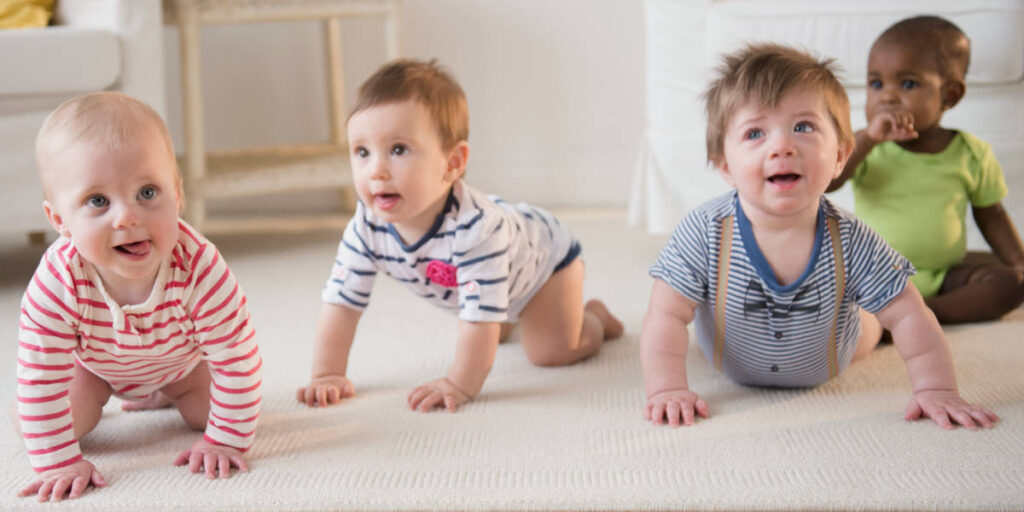When do babies start crawling? Parents and caregivers have an exciting opportunity to be part of a baby’s journey toward crawling! By understanding the milestones associated with this development, they can provide safe and stimulating environments that will best support their little one’s growth. This informative guide offers helpful insights as to when babies typically start cuddling, its importance for overall physical health & mental well-being, plus practical tips on how parents/caregivers can create crawler-friendly spaces.

Parents and caregivers have a crucial role to play in providing an optimal environment for a baby’s growth. This guide will show them the way, journeying through information on different types of crawling, typical development milestones – plus signs that their little one may not be progressing as anticipated within this milestone. With such essentials at hand, parents & caretakers can help ensure their child is firmly planted for success!
Benefits of a baby crawling
Crawling is an exciting step in your baby’s development. It encourages exploration and strengthens their physical abilities, teaching them the skills they need to maneuver around on two feet! With practice comes progress; soon enough babies can crawl with confidence into a whole new world waiting for discovery.
When Do Babies Start Crawling?
Learning to crawl is an important milestone in a baby’s development journey. The age at which this occurs can vary but typically falls somewhere between 12 and 18 months old – taking into account factors such as physical and mental growth rate, the environment they are in, and their overall well-being. So keep your eyes peeled for those little worm wriggles!
Factors that impact baby crawling
Crawling is a milestone that carries huge significance in a baby’s development, and the timing of when it happens can vary greatly. Age, genetics, and environment are key factors influencing this; however, muscle strength & flexibility may also play an important role for some babies who take their first steps earlier than others.
Not every baby will crawl at the same pace — some may take a little longer than others. There could be a variety of factors impacting this, from physical limitations to learning styles.
- From the earliest stages of development, some babies may find it difficult to coordinate their movements. This can make getting around on their own a real challenge!
- While most babies begin to crawl around the same age, some may need more time to master their limbs. With proper guidance and practice, they will move ever closer to taking those first steps!
The average age at which babies start crawling
At around 14 months old, babies are ready to take their first wonderfully wobbly steps. Crawling is an incredible milestone for a baby’s development; it helps them understand how to navigate the world and strengthen vital communication skills as they grow up. It also serves crawlers with invaluable independence – now that truly has its own rewards!
The difference in crawling patterns
Crawling speed is a spectrum among infants; some creep along while others traverse swiftly. While the difference between these two extremes isn’t always obvious to parents, it may depend on many factors like muscular strength and aptitude for coordination. Of course, differences in curiosity levels can also have an impact – some babies just naturally love exploring their world more than others!
Developmental Milestones of Baby Crawling
Babies have a lot to learn about their new environment, and learning how to crawl is an important part of the journey! Between 12 – 16 weeks old babies will start on this milestone adventure. Crawling helps them move around more freely which in turn leads to improved coordination and mobility – something that’ll surely become handy as they continue exploring the world around them.
Physical development requirements for baby crawling.
Babies usually start crawling between the age of one and 1.5 but some tots take a little longer, potentially up until 2 years old!
Crawling is a crucial milestone in baby development, allowing them to gain independence and learn about the world around them. Through this important skill, babies can build strength as they cultivate their gross motor skills.
Cognitive development needed for baby crawling
Crawling isn’t just a sign that your baby is growing – it’s an exciting milestone in their cognitive development! While babies are learning to explore the world around them, crawling encourages communication and interaction with those closest to them. It truly is one of the most important steps on their journey of discovery!
Emotional development necessary for crawling
Crawling is a major moment for young children, both in terms of physical and emotional growth. As little ones explore their environment with newfound mobility, they discover how to interact with the world around them – learning about social cues through communication as well as honing motor skills along the way.
Encouraging Baby Crawling
Your baby’s journey to mobility is just beginning! Encourage their exploratory spirit by placing interesting objects in their path and watch as they progress from crawling with small items, to larger and more physically challenging ones. It’s an adventure that you’ll both enjoy together!

If your baby is not yet ready to crawl, there are still plenty of ways to help them foster their motor skills and coordination. To get started on the path towards successful movement development, consider providing toys or activities that involve crawling-like motions!
Safety considerations when encouraging baby crawling
Crawling is the perfect way for babies to discover the world around them and develop their motor skills – but safety must come first! As your little one takes on this exciting journey, be sure to keep an eye out for potential hazards. A safe and comfortable environment will help ensure that they fully enjoy every moment of exploration!
As you help your little one get ready to explore the world on their hands and knees, make sure they have a safe environment. Clear out any potential hazards by removing objects with sharp edges or that could be easily tripped over. For an extra layer of protection, stay nearby so you can lend them assistance if needed!
Tips for encouraging baby crawling
Supporting your baby’s development is a vital part of being an attentive parent. As your little one reaches the exciting milestone of crawling, there are some strategies you can use to encourage them! Make sure they have plenty of stimulating and fun activities that allow them to be curious while learning – it will help strengthen their muscles too. Also don’t forget: patience during this new journey goes a long way!
- As your little one begins to explore the world of crawling, let them know how much fun it is! Encourage their movement by making playful noises such as claps and bangs. This simple action will help the baby learn that sound accompanies motion, aiding in early learning development.
- Give your infant lots of opportunities for playtime! Not only will it provide them with priceless moments of entertainment, but baby toys can also help cultivate motor skills and open up new avenues of exploration.
- Providing your infant with a safe and stimulating environment is key to developing their self-esteem and feelings of security. Encourage healthy growth by introducing new experiences that are age appropriate; this will help foster strong emotional development in the long run.

Conclusion
As a parent, it’s exciting to witness your child take their first steps towards independence! Crawling is an important milestone for babies and plays a crucial role in developing coordination, strength, and curiosity as they explore the world around them. Knowing when you can expect this developmental breakthrough – along with ways that you can support your baby through the process – are key elements of successful parenting during these early years.
With a proper roadmap and plenty of encouragement, you can help your little one take their first steps towards an incredible journey ahead! It’s amazing to watch them explore the world – but do be patient as they learn new skills along the way. I hope you find this blog helpful for you, and if you do, please share this with your loved ones and friends. You are also welcome to visit our blog section for more tips and recommendations..
Reading suggestions:


